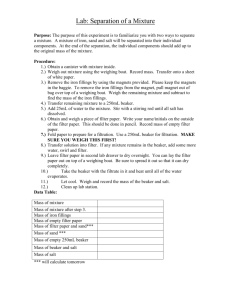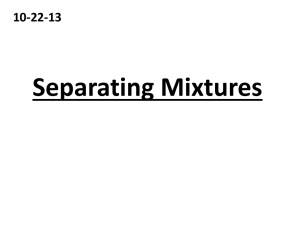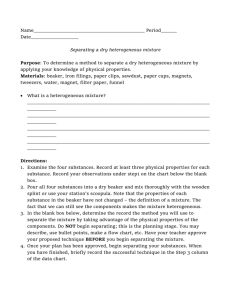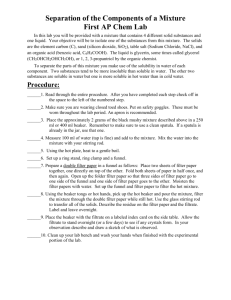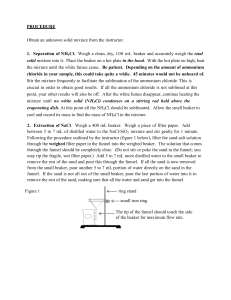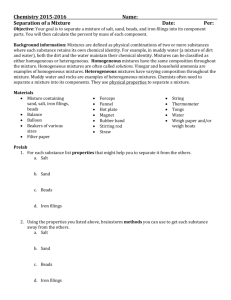Separation Lab 2014
advertisement
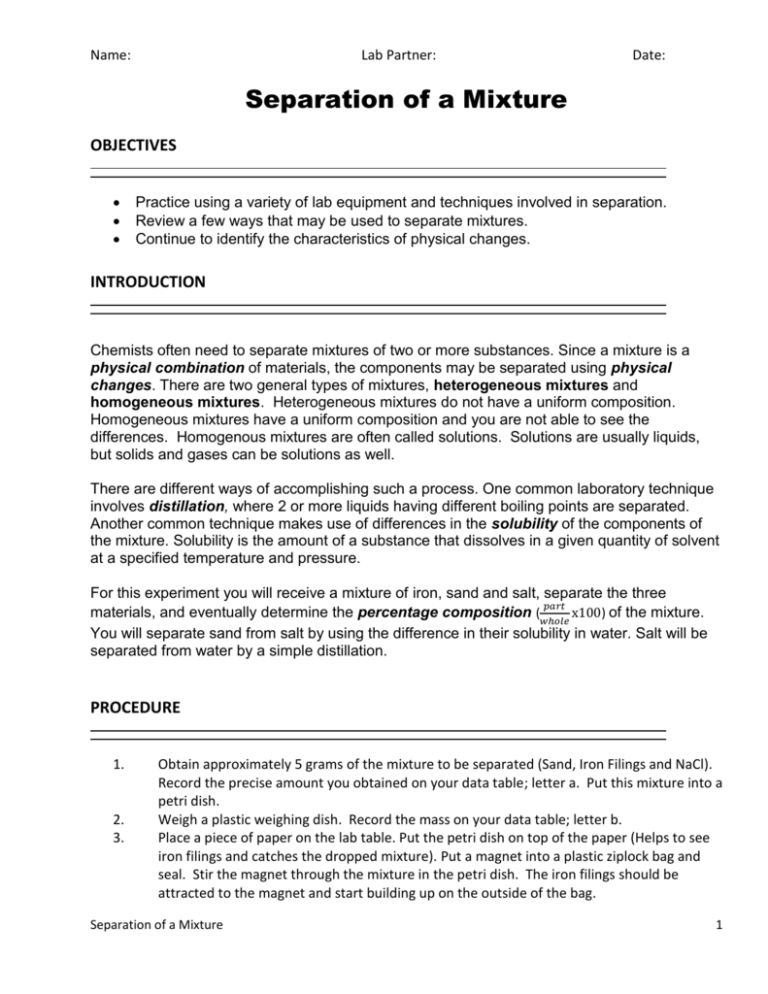
Name: Lab Partner: Date: Separation of a Mixture OBJECTIVES Practice using a variety of lab equipment and techniques involved in separation. Review a few ways that may be used to separate mixtures. Continue to identify the characteristics of physical changes. INTRODUCTION Chemists often need to separate mixtures of two or more substances. Since a mixture is a physical combination of materials, the components may be separated using physical changes. There are two general types of mixtures, heterogeneous mixtures and homogeneous mixtures. Heterogeneous mixtures do not have a uniform composition. Homogeneous mixtures have a uniform composition and you are not able to see the differences. Homogenous mixtures are often called solutions. Solutions are usually liquids, but solids and gases can be solutions as well. There are different ways of accomplishing such a process. One common laboratory technique involves distillation, where 2 or more liquids having different boiling points are separated. Another common technique makes use of differences in the solubility of the components of the mixture. Solubility is the amount of a substance that dissolves in a given quantity of solvent at a specified temperature and pressure. For this experiment you will receive a mixture of iron, sand and salt, separate the three 𝑝𝑎𝑟𝑡 materials, and eventually determine the percentage composition (𝑤ℎ𝑜𝑙𝑒 x100) of the mixture. You will separate sand from salt by using the difference in their solubility in water. Salt will be separated from water by a simple distillation. PROCEDURE 1. 2. 3. Obtain approximately 5 grams of the mixture to be separated (Sand, Iron Filings and NaCl). Record the precise amount you obtained on your data table; letter a. Put this mixture into a petri dish. Weigh a plastic weighing dish. Record the mass on your data table; letter b. Place a piece of paper on the lab table. Put the petri dish on top of the paper (Helps to see iron filings and catches the dropped mixture). Put a magnet into a plastic ziplock bag and seal. Stir the magnet through the mixture in the petri dish. The iron filings should be attracted to the magnet and start building up on the outside of the bag. Separation of a Mixture 1 4. 5. 6. 7. 8. 9. 10. 11. 12. Hold your magnet and bag over the sheet of paper. Wipe the iron filings into the plastic weighing dish. Repeat steps 3 and 4 if you think you have not removed all of the iron from the mixture. When you are confident that you have removed all of the iron filings from the mixture, you may weigh the plastic weighing dish and iron filings. Record this mass on your data table; letter c. Obtain a piece of filter paper, label it with your name along the edge (TIP: use pencil, because pen tends to run when it gets wet). Find the mass of the filter paper and record the mass of the filter paper on your data table; letter d. Weigh a clean and dry 400 mL beaker and watch glass. Record on your data table; letter e. Add 25.0 ml of distilled water to your sand and salt mixture in the 250 ml beaker. Place your beaker and mixture on your hot plate. Heat the mixture until gently boiling, stirring occasionally. Turn off the hot plate and remove the beaker with the beaker tongs. Place the beaker on the wire gauze. Fold your filter paper (Figure 1) and put it in your funnel (TIP: squirt a small amount of water on the filter paper with your wash bottle to help hold the filter paper in the funnel). Put the funnel in the funnel holder at your table. Place the 400 mL beaker under the funnel. Figure 1 13. Swirl and pour your now cooling mixture through the filter paper and funnel. This is capturing the insoluble sand. (Figure 2) Figure 2 14. 15. 16. 17. Use your wash bottle to rinse out any remaining sand in your beaker. (TIP: Use as little water as possible, because the more water you use now, the more you will have to evaporate later.) Use your wash bottle to rinse the material (sand) in the filter paper with a small quantity of water. Place your filter paper in the heating oven until dry. (NOTE: This may take longer than the lab period so you may have to weigh them the following day.) Place your 400 mL beaker on your hot plate uncovered and bring to a boil. SLOWLY evaporate the water away. Cover the beaker with your watch glass (concave side up) when Separation of a Mixture 2 18. 19. 20. 21. there is just a skim of water on the bottom. When the water level gets very low the solution may start to pop, scattering your material all over the counter top Once the water is completely evaporated from your 400 mL beaker, turn off the hot plate and let it cool by placing it on wire gauze. Use beaker tongs to remove the beaker from the hot plate. You may also carefully remove the watch glass and invert it on the table to help cooling and final evaporation. When the beaker and evaporating dish are cool weigh the 400 mL beaker, watch glass and the soluble component (NaCl). Record this data on your data table; letter g. Check your filter paper and sand. If they are dry you may weigh them. Record your mass on your data table; letter f. Calculate the percent by mass of each component in the mixture. Show all work and units!!!! DATA and OBSERVATIONS a. Mass of Mixture b. Mass of plastic weighing dish c. Mass of plastic weighing dish and iron filings d. Mass of Filter Paper e. Mass of 400 mL Beaker and Watch Glass f. Mass of Filter Paper and Sand g. Mass of 400 mL Beaker, Watch Glass and NaCl Separation of a Mixture 3 ANALYSIS and CONCLUSIONS – Show work, significant digits and units. 1. Determine the mass of the iron filings. 2. Determine the mass of the sand. 3. Determine the mass of the NaCl. 4. Determine the percentage composition of the iron filings. 5. Determine the percentage composition of the sand. 6. Determine the percentage composition of the NaCl. 7. Identify the type of mixture in each of the following steps: a. Step 1 b. Step 9 c. Step 17 8. Describe the methods that were used to separate the sand, salt and iron from each other. Discuss the physical properties of each substance that were used to assist in the separation. Separation of a Mixture 4

